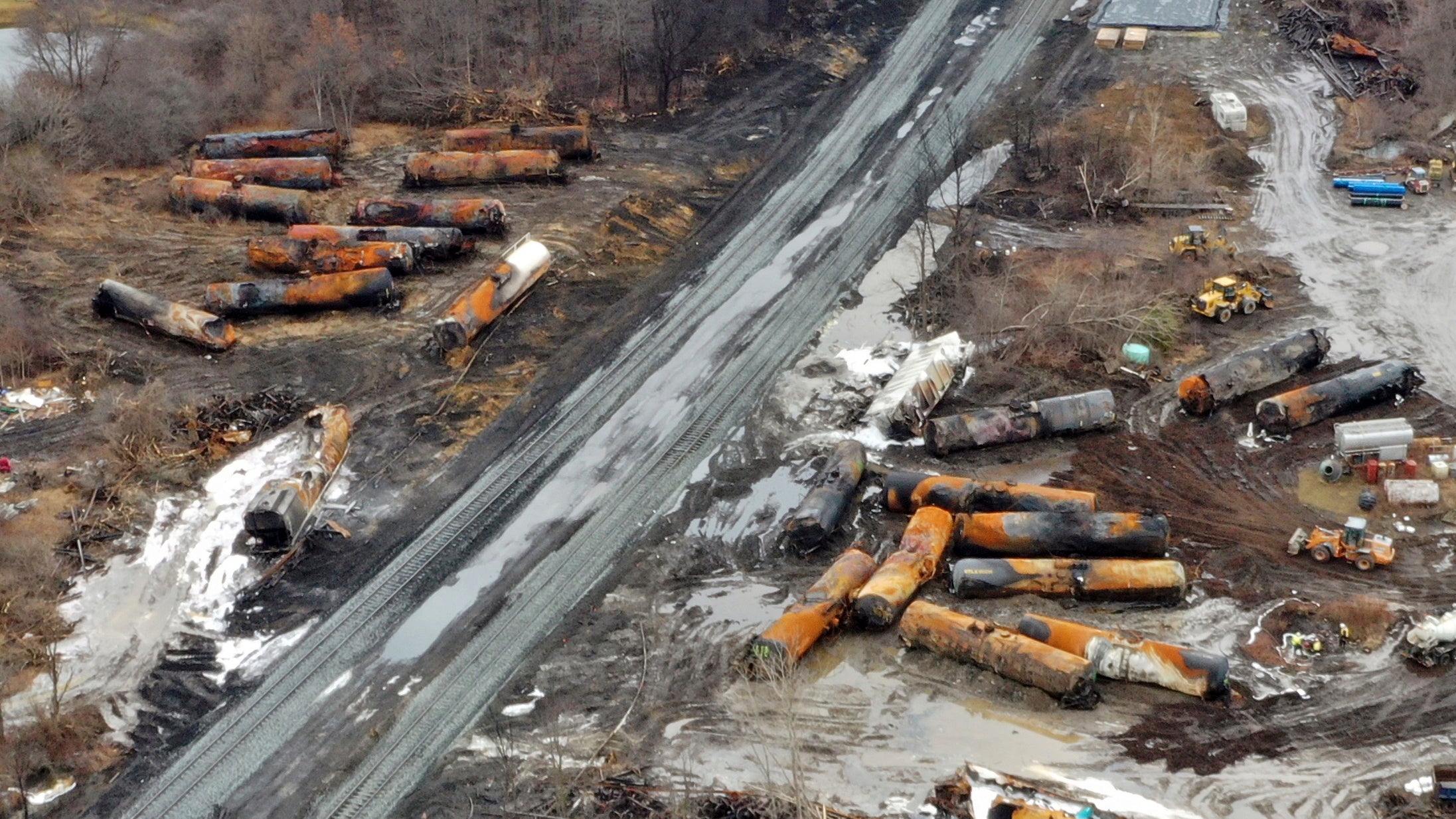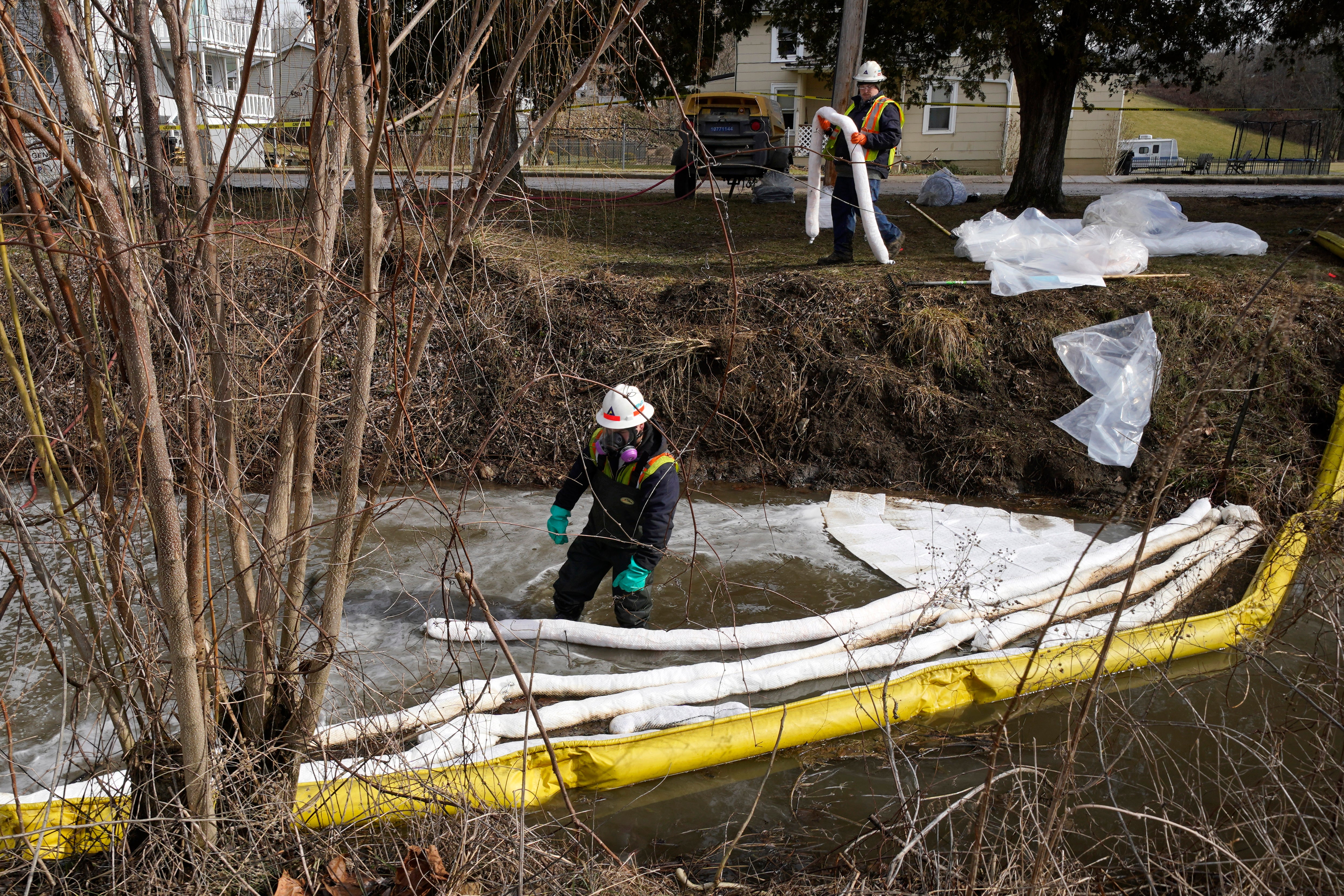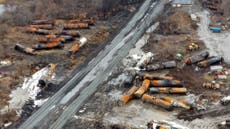Dead animals and reports of sickness as ecological disaster unfolds after Ohio toxic train derailment
Louise Boyle reports on the environmental impacts of a train derailment in Ohio which released toxic chemicals into the air, surface soils, and waters


Your support helps us to tell the story
From reproductive rights to climate change to Big Tech, The Independent is on the ground when the story is developing. Whether it's investigating the financials of Elon Musk's pro-Trump PAC or producing our latest documentary, 'The A Word', which shines a light on the American women fighting for reproductive rights, we know how important it is to parse out the facts from the messaging.
At such a critical moment in US history, we need reporters on the ground. Your donation allows us to keep sending journalists to speak to both sides of the story.
The Independent is trusted by Americans across the entire political spectrum. And unlike many other quality news outlets, we choose not to lock Americans out of our reporting and analysis with paywalls. We believe quality journalism should be available to everyone, paid for by those who can afford it.
Your support makes all the difference.The ecological fallout from the derailment of a freight train carrying toxic materials in rural Ohio is still being determined days after the disaster.
Around 50 train cars derailed on 3rd February in the small town of East Palestine including 20 cars carrying hazardous substances.
No one was killed after a broken axle sent the Norfolk Southern train careening off the tracks, investigators said. More than 2,000 residents were evacuated due to health concerns over the chemical leak but have since been allowed to return.
Some of the crashed cars were carrying toxic chemicals - vinyl chloride, butyl acrylate, ethylhexyl acrylate, and ethylene glycol monobutyl ether - which were released into the air, surface soils, and surface waters.
Five rail car tankers of vinyl chloride were intentionally breached by crews, and the substance diverted to an excavated trench. A controlled detonation was then carried out to prevent an explosion, sending noxious black clouds billowing across the area. One of the substances released was phosgene, a gas deployed as a chemical weapon in the First World War.
Environmental remediation work was ongoing, Norfolk Southern reported last week, along with air, soil, and water monitoring in coordination with state and federal agencies. Regulators have said that so far the air quality remains safe and drinking water supplies have not been affected in surrounding communities.
The US Environmental Protection Agency (EPA) said on Tuesday that it carried out “robust air-quality testing” and had “not detected any levels of health concern that can be attributed to the incident”.
But in the 12 days since the disaster, a number of troubling reports have emerged. Some residents have spoken of headaches and feeling sick, the Associated Press reported.
East Palestine resident Melissa Henry told AP how she had taken her two sons to her parents’ house outside of the evacuation zone after her youngest boy’s “eyes turned red as tomato and he was coughing a lot”.
She said that since returning to her home, she had been doing laundry, cleaning and changing filters in the furnace.
“I don’t know if that’s going to work, but we have to do something,” she said.
Chris and Jamie Wallace told NewsNation that they and their three-year-old child were diagnosed with upper respiratory infections after going to hospital with breathing difficulties.
Vinyl chloride, which is used to make plastic pipes, wires and packaging, is associated with an increased risk of a rare form of liver cancer, hepatic angiosarcoma, along with primary liver cancer, brain and lung cancers, lymphoma, and leukemia, Cancer.gov reports.


One resident in the town of North Lima, around ten miles from the train derailment, reported that her six chickens died in the days after the fire.
“My video camera footage shows my chickens were perfectly fine before they started this burn, and as soon as they started the burn, my chickens slowed down and they died,” Amanda Breshears told local TV station WKBN27.
It was not the only report of sick animals. Taylor Holzer, a registered foxkeeper who lives outside the evacuation perimeter, told WKBN that all of his foxes were sick and one had died. Dead fish were also observed floating in local streams.
A legal notice sent to the train operator by the EPA contained further details of contamination.
Hazardous materials were found in samples taken from a number of waterways in the area - Sulphur Run, Leslie Run, Bull Creek, North Fork Little Beaver Creek, Little Beaver Creek, and the Ohio River.
Materials related to the incident were also observed entering storm drains, EPA noted. The agency also highlighted that areas of contaminated soil and free liquids were observed and potentially covered and/or filled during reconstruction of the rail line.
Environmental activist Erin Brockovich criticized the EPA and state lawmakers for telling people it was safe to return to their homes and at the same time, sending a legal notice to the rail operator over the threat of environmental contamination.
“This is why people don’t trust government,” she tweeted on Monday.
“You cannot tell people that there has been and continues to be hazardous pollutants contaminating the environment while at the same time saying ‘all is well.’”
A water company in the neighboring state of West Virginia said on Sunday that it would be taking precautionary measures over its water supply.
West Virginia American Water said that there has been no change in its intake from the Ohio River but the utility would set up a secondary source on the tributary, Guyandotte River.
A lawsuit was filed last week against Norfolk Southern, seeking unspecified damages and to demand that the rail company pay for medical screenings and related care for residents within a 30-mile radius of the train explosion.
The derailment has also raised questions about the frequent use of rail transportation to move vast quantities of toxic and dangerous substances in close proximity to communities.

Rail unions believe the industry has gotten riskier in recent years after widespread job cuts left workers spread thin, the AP reported. Hazardous materials account for about 7-8 per cent of the 30 million shipments that railroads deliver across the country every year.
“It raises all kinds of questions,” Ohio Governor Mike DeWine told Fox & Friends when he was asked whether hazardous materials are too dangerous to transport by rail.
“We’ve seen it up close and personal the last few days,” Gov. DeWine said. “This is a big, big deal.”
On Tuesday, he told reporters that the railroad was not required to notify Ohio about toxic chemicals travelling through the state because the majority of the cars didn’t contain a hazardous substance and so the train, overall, wasn’t classed as a “high hazardous material train”.
He branded this process “absurd” and called on Congress to take action.
“Frankly, if this is true and I’m told it’s true, this is absurd and we need to look at this and Congress needs to take a look at how these things are handled,” he said.
“We should know when we have trains carrying hazardous material that are going through the state of Ohio.”
On 6th July 2013, a 73-car freight train derailed in the center of the town of Lac-Mégantic in Quebec, Canada, resulting in a huge explosion. Some 47 people were killed and roughly half the town was burned down.
In February 2020, a landslide in Kentucky caused the derailment of a freight train carrying ethanol which led to a fire and chemical leak into a river. A 2005 derailment in Graniteville, South Carolina, left nine people dead and injured more than 250 after toxic chlorine gases were released.
This article has been updated




Join our commenting forum
Join thought-provoking conversations, follow other Independent readers and see their replies
Comments